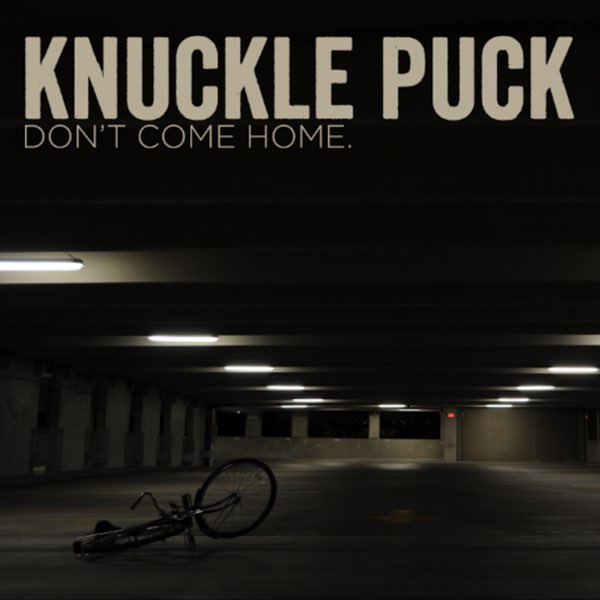Killer Klassix: Knuckle Puck: “Don’t Come Home”
The band capitalizes on an abstract composition to entice the listener and using relative, vulnerable lyrics to perfectly match melody to sentiment.

April 10, 2023
“Don’t Come Home” is an explosive debut for an eager four piece Chicago pop punk natives, Knuckle Puck. In a five-track exploration of discovering and understanding home as either a place or a concept, the band capitalizes on an abstract composition structure, exhibiting polymelodies to entice the listener and using relative, vulnerable lyrics to facilitate the breakdown of subject matter; perfectly matching melody to sentiment. Fans of the genre will be able to hear influences pulling from a range of Chicago pop punk bands such as Real Friends, Fall Out Boy and Spitalfield.
The process of how the band got together was heavily tied to the production of the EP, which released on October 30, 2012. According to their oral history published in a video by Alt Press, Knuckle Puck was conceptualized “in the suburbs of Chicago, during the senior year of high school when vocalist and lyricist Joe Taylor originally reached out via Facebook to drummer, John Siorek.”
Both musicians expressed a desire to “be in a new band” and also “reached out via Twitter” to their lead guitarist, Kevin Maida. Afterwhich, the band played shows while still missing a lead guitarist. The final addition of rhythm guitarist Nick Casasanto in mid-2011 led to recording a 3-track demo in Casasanto’s mom’s kitchen. Once released Siorek remarked a definitive moment for the band, citing a show in mid-2011 where the turnout was slightly larger, made up of strangers, but the fans “knew the words to the songs they were playing.” Taylor describes “Don’t Come Home” as the band’s “last shot,” noting the expense of production, but highlighting a bond established in an effort to take a risk with his band mates.
“Townsend,” bursts forth as the initial track of the EP. The lyrical composition perfectly captures the mental anguish of ending a failing relationship in an effort to preserve self-worth. The track highlights the experimental aspect of Knuckle Puck’s unique song structure, with the chugging of the rhythm guitars, emphasizing a captivating rhythm and embedded melody perfectly built up toward the end of the chorus. The tracks’s brilliant chaotic composition proves symbolic, using the background track as a representation of unhealthy, toxic interactions noted in dysfunctional homes. Essentially the track highlights multiple musical themes that distinguish Knuckle Puck from the newer wave of pop punk bands.
“Give Up” is the single from the EP. A wonderful song dedicated to persistent failure and self-deprecation. The track is energetic with a rhythmic melody that challenges the lyrics. Within the EP, it introduces home not as a place, but an idea, particularly in the form of a bad relationship. The lyrics describe a brokenhearted person, presumably Taylor, who has become so accustomed to being mistreated from his relationships he now understands abuse as the only truth in his life. “I’m playing with matches/and burning down the road straight to your mattress/but never finding hope to combat the rotting in my chest/and now you can’t find my signs of life/you are my north star, my lighthouse/the only thing that helps me come back home.” Where most “emo” pop punk songs capitalize on the pathos in particular, Taylor’s musical intuition and connection with the band captured in the melodic breakdown of the song that shifts the song from the struggle to the emotive, allows his message to shine through.
“Stuck” is a powerful experimental punk track. Contrary to the stagnant theme of the EP, the track is crafted as a love song. Noted by Taylor’s change in pitch– switching from an aggressive vocal stance to a more tender and approachable melodic performance– the lyrics center the EP in a strong sense of discovery of identity and ability. Revisiting the idea of home as not a place, but an idea; Taylor’s lyrics denote home as an environment that nurtures one character and enables them to seek, to become, and to solidify the person they are. The dynamic of melodic guitar, established by Maido and Casasanto, shows how whimsy the melodies can be though they only further the track’s message in the song’s chorus, “this is therapy for me/this is what helps me keep on going/I can’t put this much heart into anything else/I hope you see that this means everything to me.”
You have to really mess up and know how bad you messed up to start forming a real idea of home. If you are straying from home, you may be in line with four friend’s from the Chicago suburbs who home-recorded an EP. So maybe home could be a place. Maybe home exists beyond our reach and exists within a state of mind. There could very well be the possibility that home is not home, and we have to embark on our own paths to find home for ourselves and possibly define the word for ourselves. For only when we take the first steps away from what we know as home are we that much closer to either returning to home, or forgoing our preconception all together.
5/5

















